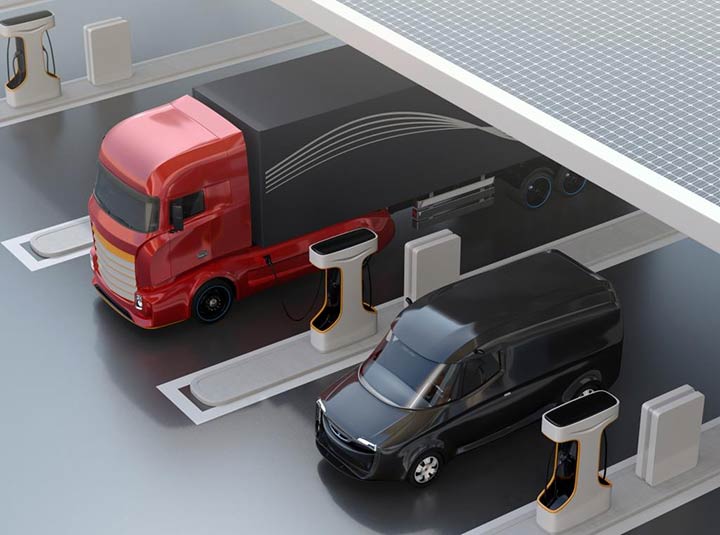EVI-EnSite: Electric Vehicle Infrastructure – Energy Estimation and Site Optimization Tool
NLR's Electric Vehicle Infrastructure – Energy Estimation and Site Optimization tool (EVI-EnSite) is a charging station design, modeling, and analysis tool.
Researchers use EVI-EnSite to conduct studies related to the development of electric vehicle (EV) charging station infrastructure as well as the operation and quality of service at such stations. The flexible tool can simulate light-, medium-, and heavy-duty EV charging at different charging station configurations—from low-power charging scenarios (i.e., Level 1 and Level 2) to high-power, direct current fast-charging (DCFC) stations at the multimegawatt scale.

Key Capabilities
The EVI-EnSite tool can:
- Investigate novel station energy management systems and vehicle charging algorithms and procedures
- Design station configuration based on port, power, and energy requirements
- Model vehicle queuing or plugging-in depending on the availability of desired charging port(s)
- Incorporate closed-loop battery management system (BMS) control actions using state-of-charge (SOC) and charging power lookup tables (i.e., charge-acceptance curves)
- Generate station load profiles using stochastic or deterministic vehicle schedules
- Analyze charging station operation with heterogeneous port configuration (i.e., ports with different power capacities)
- Estimate station performance and quality-of-service metrics
- Evaluate and anticipate future infrastructure needs.
How It Works
EVI-EnSite runs detailed charging station simulations, outputting time-series data pertaining to station charging load, port-wise charging load, and vehicle-wise charging and heat generation. It calculates station metrics such as average charging/waiting time, average/maximum charging load, and peak-to-average load ratio, etc.
EVI-EnSite can analyze a specific station using deterministic vehicle arrival schedules or run a sweep of operation scenarios using stochastic vehicle arrival data and a Monte Carlo simulation technique. As an agent-based tool, EVI-EnSite includes two primary agents: a vehicle agent and a charging station agent.
Vehicle Agent
The vehicle agent is defined by arrival time, initial SOC, battery capacity, and a charge-acceptance curve. The vehicle's charge-acceptance curve—which maps the battery pack's SOC and maximum charging power—acts as a proxy to emulate complex BMS control algorithms. By using this curve, EVI-EnSite ensures that battery charging power is limited by either the port power capacity or the BMS control action.
Station Agent
The station agent is defined by the number of charging ports, port capacity, station capacity, and the station's energy management system. When a vehicle arrives at the station, following an underlying arrival schedule, it is either plugged into a charging port, if available, or queued if all the ports are occupied. During charging, the vehicle agent estimates the SOC and relays it to the station controller. Charging is completed when the battery pack reaches a given SOC target or a designated stop time.
Default Station-Level Control
The default station-level control incorporates a decentralized charging approach, where vehicles are charged with the maximum available power, subject to the vehicle agent and station capacity limits. EVI-EnSite can also integrate centralized controllers for optimizing EV charging loads, stationary energy storage, and on-site energy generation.
Publications
Note: The EVI-Ensite tool was previously known as the DCFC Station Simulation Model in some publications.
A Comparison of AC and DC Distribution Architectures for Electric Vehicle High Power Charging Facilities, IEEE Energy Conversion Congress and Exposition (2024)
Grid Voltage Control Analysis for Heavy-Duty Electric Vehicle Charging Stations, IEEE Power and Energy Society Innovative Smart Grid Technologies Conference (2021)
Contact
Contact us at [email protected] for more information.
Share
Last Updated Dec. 6, 2025
